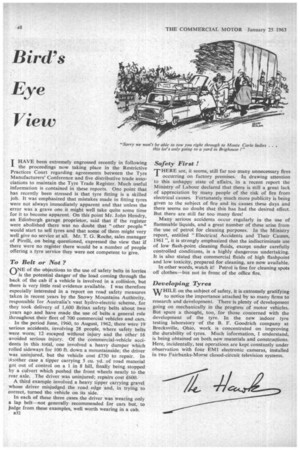Bird's Eye View
Page 50

If you've noticed an error in this article please click here to report it so we can fix it.
IHAVE been extremely engrossed recently in following the proceedings now taking place in the Restrictive Practices Court regarding agreements between the Tyre Manufacturers' Conference and five distributive trade associations to maintain the Tyre Trade Register. Much useful information is contained in these reports. One point that has recently been stressed is that tyre fitting is a skilled job. It was emphasized that mistakes made in fitting tyres were not always immediately apparent and that unless the error was a grave one it might well take quite some time for it to become apparent. On this point Mr. John Hendry, an Edinburgh garage proprietor, said that if the register were abolished there was no doubt that "other people" would start to sell tyres and that some of them might very well give no service at all. Mr. T. G. Roche, sales manager of Pirelli, on being questioned, expressed the view that if there were no register there would be a number of people offering a tyre service they were not competent to give.
To Belt or Not ?
QE of the objections to the use of safety belts in lorries
is the potential danger of the load coming through the back of the cab if a vehicle is involved in a collision, but there is very little real evidence available. I was therefore especially interested in a report on road safety measures taken in recent years by the Snowy Mountains Authority, responsible for Australia's vast hydro-electric scheme, for they took delivery of 1,600 Britax safety belts about two years ago and have made the use of belts a general rule throughout their fleet of 700 commercial vehicles and cars.
• In the period June, 1960, to August, 1962, there were 19 serious accidents, involving 28 people, where safety belts were worn; 12 escaped without injury and the other 16 avoided serious injury. Of the commercial-vehicle accidents in this total, one involved a heavy dumper which rolled sideways for 100 ft. down a mountainside; the driver was uninjured, but the vehicle cost £750 to repair. In tilother case a tipper carrying 5 cu. yd. of road material got out of control on a 1 in 8 hill, finally being stopped by a culvert which pushed the front wheels nearly to the rear axle. The driver was uninjured; repairs cost £600.
A third example involved a heavy tipper carrying gravel whose driver misjudged the road edge and, in trying to correct, turned the vehicle on its side.
In each of these three cases the driver was wearing only a lap belt—not generally recommended for cars but, to judge from these examples, well worth wearing in a cab.
Safety First !
THERE are, it seems, still far too many unnecessary fires I occurring on factory premises. In drawing attention to this unhappy state of affairs, in a recent report the Ministry of Labour declared that there is still a great lack of appreciation by many people of the risk of fire from electrical causes. Fortunately much more publicity is being given to the subject of fire and its causes these days and there seems no doubt that this has had the desired effect. But there are still far too many fires!
Many serious accidents occur regularly in the use of flammable liquids, and a great number of these arise from the use of petrol for cleaning purposes. In the Ministry report, entitled "Electrical Accidents and Their Causes, 1961 ", it is strongly emphasized that the indiscriminate use of low flash-point cleaning fluids, except under carefully controlled conditions, is a highly dangerous undertaking. It is also stated that commercial fluids of high flashpoint and low toxicity, prepared for cleaning, are now available.
In other words, watch it! Petrol is fine for cleaning spots off clothes—but not in front of the office fire.
Developing Tyres
WHILE on the subject of safety, it is extremely gratifying to notice the importance attached by so many firms to research and development There is plenty of development going on mechanically in the progress of motor vehicles. But spare a thought, too, for those concerned with the development of the tyre. In the new indoor tyre testing laboratory of the B. F. Goodrich company at Brecksville, Ohio, work is concentrated on improving the durability of tyres. Much information, I understand, is being obtained on both new materials and constructions. Here, incidentally, test operations are kept constantly under observation with four EMI electronic cameras, installed in two Fairbanks-Morse closed-circuit television systems.
















































































































